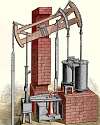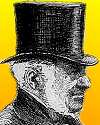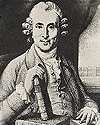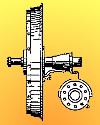
On 13 July 1781, a British patent was taken out by an English mining engineer, Jonathan Carter Hornblower, for the first compound steam engine. Boulton and Watt, who jealously guarded their patent rights as the commercial developers of steam engines, were not impressed.
Hornblower's family had shown inventive genius for two generations, and their interesting family history is described in this article from Dictionary of National Biographies (1901). At the end of the web page are links to further information on Hornblower's steam engine design.

On 13 Jul 1887, the second Tay Rail Bridge was opened in Scotland (and remains in use today). It was built to replace the original single-track railway which suffered a disastrous collapse during a gale in 1879. The passenger train crossing at the time plunged with everyone abroad to their deaths. It had been, for just 19 months, the longest bridge in the world. It is now known, to date, as the worst structural engineering failure in British history. Today's book pick is: Beautiful Railway Bridge of the Silvery Tay: reinvestgating the Tay Bridge disaster of 1879, by Peter R Lewis, a university engineering professor and acknowledged expert on the Tay Bridge Disaster. He gives the bridge’s history, evaluates the tragedy, and details how the Tay Bridge started to suffer irreparable damage of its joints (poorly designed and built) from the day that it carried trains, and that metal fatigue, rather than the gale, played a key role in its deterioration.
It is available from Amazon, typically about New from $19.23. Used from $5.39. (As of earlier time of writing - subject to change.)
 | The hand is where the mind meets the world. |
 | We really try to have only one new particle per paper. |
 | All of us are interested in our roots. Generally this interest is latent in youth, and grows with age. Until I reached fifty I thought that history of science was a refuge for old scientists whose creative juices had dried up. Now of course I know that I was wrong! As we grow older, we become more interested in the past, in family history, local history, etc. Astronomy is, or was when I started in it, almost a family. |
| Before you look at today's web page, see if you can answer some of these questions about the events that happened on this day. Some of the names are very familiar. Others will likely stump you. Tickle your curiosity with these questions, then check your answers on today's web page. | |
| Births | |
 | A mathematician and educator, born on 13 Jul 1944, invented a toy that became popular in the 1980s. The toy consists of 26 small cubes that rotate on a central axis; nine coloured cube faces, in three rows of three each, form each side of the cube. When the cube arrangement is randomized, the player must then return it to the original condition of faces with matching colors, which is one among 43 quintillion possible configurations. Can you name this man - and name his national origin? |
 | William Hedley, born 13 Jul 1779, was an English coal-mine official and inventor who was probably the first to build a commercially useful steam locomotive with driving wheels using the natural friction between their rims and the rails. The locomotive he put in service in 1813 to haul 50-ton coal wagons on a five-mile line was not retired until 1862. What was the name of this famous locomotive? |
| Deaths | |
 | Gabriel Lippmann (1845-1921) was a French physicist, who received the Nobel Prize for Physics in 1908 for an advance in photography. Lippmann was a giant of his day in classical physics research, especially in optics and electricity. He worked in Berlin with the famed Hermann von Helmholtz before settling in Paris to head (in 1886) the Sorbonne’s Laboratories of Physical Research until his death. His inventions include an instrument for precisely measuring minute differences in electrical power. What was the invention for which he was awarded a Nobel Prize? |
 | James Lind (1716-1794) was a Scottish physician, “founder of naval hygiene in England,” whose recommendation on the diet of seamen resulted in the prompt eradication of scurvy from the British Navy. (The Dutch had implemented this practice almost two centuries earlier.) Lind also recommended shipboard delousing procedures and suggested the use of hospital ships for sick sailors in tropical ports. In 1761, he arranged for the shipboard distillation of seawater for drinking water. What was the life-saving change in diet he recommended? |
| Events | |
 | On 13 Jul 1836, John Ruggles of Thomaston, Maine received a patent from the U.S. Patent Office, for a traction wheel used in locomotive steam engines. Before this one, there had been 9,957 patents issued. Ruggles was Chairman of the Committee on Patents of the U.S. Senate, and was instrumental in patent law reform. However, in 1838, a Senate select committee investigated corruption charges against Senator Ruggles relating to a patent application. What was the U.S. Patent Number of Ruggles' patent? |
 | On 13 Jul of a certain year, a power failure blacked out New York. Starting at about 9 pm, four lightning strikes on high-voltage transmission lines within a half-hour knocked out electricity and plunged millions of residents of New York City into darkness. Because of social tensions of the times, mobs set fires, smashed windows and hauled away food, clothing and appliances. It took 25 hours to restore power entirely. There were about 4,500 people arrested, and damage estimated at $61 million. In which decade did this happen? |
Fast answers for the previous newsletter for July 12: Buckminster • George Eastman • outboard motor • Panama Canal • foghorn.
 If you enjoy this newsletter, the website, or wish to offer encouragement or ideas, please send feedback by using your mail reader Reply button.
If you enjoy this newsletter, the website, or wish to offer encouragement or ideas, please send feedback by using your mail reader Reply button. Your click on a Facebook, StumbleUpon, or other social button on the site webpages is also a welcome sign of appreciation. Thank you for using them.
© This newsletter is copyright 2020 by todayinsci.com. Please respect the Webmaster's wishes and do not put copies online of the Newsletter — or any Today in Science History webpage. (If you already have done so, please remove them. Thank you.) Offline use in education is encouraged such as a printout on a bulletin board, or projected for classroom viewing. Online, descriptive links to our pages are welcomed, as these will provide a reader with the most recent revisions, additions and/or corrections of a webpage. For any other copyright questions, please contact the Webmaster by using your mail reader Reply button.
--
If you do not want to receive any more newsletters, Unsubscribe
To update your preferences and to unsubscribe visit this link
Executive Real Estate Business Class
-
"It was like a man with wings. It wasn't like anything you'd see on TV or in a monster movie." ...
About the publisher
Search This Blog
Blog Archive
-
▼
2020
(1542)
-
▼
July
(200)
- PHOTOGRAPHY: The danger of documenting sharks
- Meet The Serial Killer Who Ate His Victims Because...
- The Roundup Top Ten from History News Network
- On This Day for July 31 - Lunar Roving Vehicle fir...
- Newsletter for Friday 31 July.
- Lockdowns killing more children than COVID + Docto...
- YOUR WEEKLY ESCAPE: Revisiting an iconic Nat Geo c...
- July 31: The Pilgrim Fathers Depart and the Battle...
- ANIMALS: The dog that got COVID-19
- On This Day for July 30 - Death of Otto von Bismar...
- Newsletter for Thursday 30 July.
- Frontline Docs 2nd Video Press Conf at SCOTUS We h...
- BREAKING NEWS: First U.S. dog to test positive for...
- July 30: First Defenestration of Prague, the 1st O...
- Demystified: Why Do Wolves Howl?
- The Champs Are Back on Forged in Fire Tonight
- SCIENCE: A rush to Mars during a rough patch at home
- Breaking News from History News Network
- On This Day for July 29 - National Aeronautics and...
- Newsletter for Wednesday 29 July.
- All Social Media Censor Frontline Docs COVID Video...
- July 29: Spanish Armada Scattered and Taft's Secre...
- TRAVEL: How to stay safe if you need to travel
- On This Day for July 28 - Beginning of World War I...
- Newsletter for Tuesday 28 July.
- Video Presentation from Washington Summit: America...
- July 28: Robespierre Guillotined, Austria-Hungary ...
- HISTORY: How the vice presidency became critical
- Enjoy Summer with Nat Geo Kids Magazine
- New This Week on History News Network
- On This Day for July 27 - Terrorist attack at Atla...
- Newsletter for Monday 27 July.
- COVID Propaganda & Tyrannical Edicts Affecting Men...
- July 27: Walter Raleigh Brings Tobacco, the Atlant...
- FAMILY: Can you transfer your ‘retro fun’ to your...
- The 10 greatest discoveries made by the British pu...
- On This Day for July 26 - Suez Canal seized, John ...
- Newsletter for Sunday 26 July.
- CDC says actual # of cases is up to 13X higher tha...
- July 26: 1st Muslim Civil War, Pizarro's Royal Cha...
- The Compass: Greece
- On This Day for July 25 - American advance into Ca...
- Newsletter for Saturday 25 July.
- VIRUS UPDATE: What does COVID-19 do to a child's b...
- July 25: The 1st Steam Locomotive, Mussolini Dismi...
- PHOTOGRAPHY: The photo that shocked a nation
- This Hardened Blob Of Nuclear Waste Could Kill You...
- On This Day for July 24 - Beginning of Mata Hari's...
- The Roundup Top Ten From History News Network
- Newsletter for Friday 24 July.
- Medical Journal: make the vaccine Mandatory! + Fre...
- YOUR WEEKLY ESCAPE: The man who claims to be Jesus...
- July 24: Cartier Lands in Canada, Mary Queen of Sc...
- ANIMALS: Let’s not forget this other catastrophe
- Demystified: Are Dogs Really Color-Blind?
- On This Day for July 23 - Egyptian monarchy topple...
- Newsletter for Thursday 23 July.
- listen to Dixie Brogdon Hopson tells how the hospi...
- July 23: Upper and Lower Canada United and the Bre...
- SCIENCE: The joy of vintage comforts
- A Puzzling Challenge on Forged in Fire Tonight
- Explore King Tut's tomb with National Geographic H...
- Breaking News from History News Network
- On This Day for July 22 - Deng Xiaoping reinstated...
- CDC Knows Masks and other methods don't work to st...
- Newsletter for Wednesday 22 July.
- July 22: First Congress of Vienna and Spoonerism
- TRAVEL: When tourism returns will it be better?
- Enjoy Summer with Nat Geo Kids Magazine
- On This Day for July 21 - Egyptians defeated in th...
- Newsletter for Tuesday 21 July.
- July 21: 1st Battle of Bull Run, the Trans-Siberia...
- HISTORY: John Lewis always stood for the same thing
- New This Week on History News Network
- On This Day for July 20 - First Moon landing, Sir ...
- Newsletter for Monday 20 July.
- What Scientific Study Shows 6 feet distance or "ma...
- July 20: On This Day in History
- FAMILY: Searching for patience
- Anne of Cleves: Henry VIII's most successful queen?
- On This Day for July 19 - U.S. women's suffrage mo...
- Newsletter for Sunday 19 July.
- Mask Truth Part 2, Data by Nations shows Hydroxych...
- July 19: 1st US Women's Rights Convention and V fo...
- The Compass: Colombia
- On This Day for July 18 - Publication of Mein Kamp...
- Newsletter for Saturday 18 July.
- Enough! Mask Truth, re-Creating you! the intended...
- CORONAVIRUS SPECIAL EDITION: What type of person d...
- July 18: Spanish Civil War Begins and 7 Years of K...
- PHOTOGRAPHY: Showing a nation losing its drinking ...
- How Julia Child Went From World War 2 Spy To Belov...
- Introducing Expedition: Learn! A New Way to Help K...
- The Roundup Top Ten for July 17, 2020
- On This Day for July 17 - Beginning of the Spanish...
- Newsletter for Friday 17 July.
- July 17: Execution of the Romanovs and a Stormy Bi...
- YOUR WEEKLY ESCAPE: An intimate look inside a mode...
- ANIMALS: The trouble with 'retired' chimps
- Man vs. 800-Pound Beast! Watch New Episode of Alon...
-
▼
July
(200)
-
Blogroll
-
About
HistoryFact










0 comments:
Post a Comment